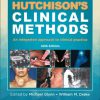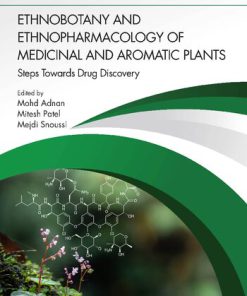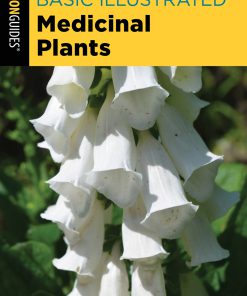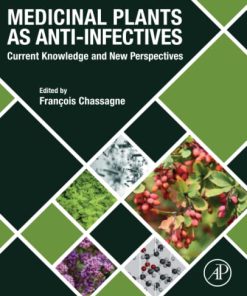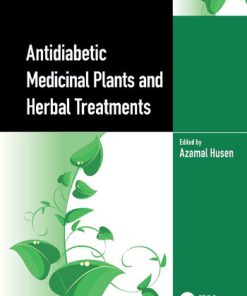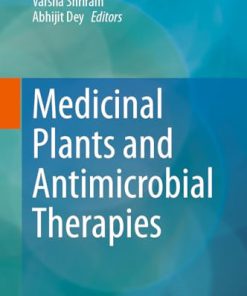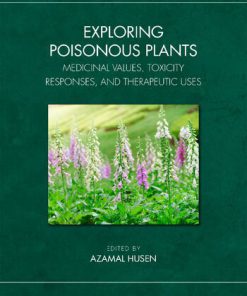Oncological Functional Nutrition Phytochemicals and Medicinal Plants 1st Edition by Maira Rubi Segura Campos, Armando Manuel Martin Ortega ISBN 9780128198285 0128198281
$50.00 Original price was: $50.00.$25.00Current price is: $25.00.
Oncological Functional Nutrition Phytochemicals and Medicinal Plants 1st Edition by Maira Rubi Segura Campos, Armando Manuel Martin Ortega – Ebook PDF Instant Download/Delivery: 9780128198285 ,0128198281
Full download Oncological Functional Nutrition Phytochemicals and Medicinal Plants 1st Edition after payment

Product details:
ISBN 10: 0128198281
ISBN 13: 9780128198285
Author: Maira Rubi Segura Campos, Armando Manuel Martin Ortega
Oncological Functional Nutrition: Phytochemicals and Medicinal Plants presents the anticancer activities, metabolism, mechanism of action, doses, and sources of various phytochemicals and medicinal plants.
Broken into five parts, this book addresses cancer epidemiology, molecular and therapeutic bases of cancer, macro and micronutrients in cancer prevention and treatment, phytochemicals in the cancer treatment, and medical plants as potential functional foods or resources for the obtention of metabolites with anticancer activity.
Written for nutritionists, food scientists, health professionals, oncologists, endocrinologists, natural product chemists, ethnobotanists, chemists, pharmacists, biochemists, and students studying relating fields, Oncological Functional Nutrition: Phytochemicals and Medicinal Plants will be a useful reference for those interested in learning more about functional nutrition and cancer.
Discusses functional nutrition as alternative therapy
Provides recommendations and intervention strategies related to the consumption of phytochemicals, food, and medicinal plants
Addresses cancer epidemiology, the molecular and therapeutic bases of cancer, phytochemicals in the cancer treatment, and medical plants
Oncological Functional Nutrition Phytochemicals and Medicinal Plants 1st Edition Table of contents:
Chapter 1 Cancer epidemiology
1.1: Introduction
1.2: Theoretical framework
1.2.1: Global cancer epidemiology
1.2.2: Related factors to cancer
1.3: Endogenous exposure
1.3.1: Cancer susceptibility
1.3.2: Spontaneous mutations
1.3.3: Epigenetics
1.3.4: Hereditary cancer
1.3.5: Chronic inflammation
1.4: Exogenous exposure
1.4.1: Infections
1.4.2: Environmental pollutants
1.4.3: Diet
1.4.4: Carcinogenesis by the process of food
1.4.5: Supplement and multivitamins
1.4.6: Lifestyle
1.4.7: Alcohol
1.4.8: Tobacco
1.4.9: Overweight and obesity
1.5: Cancer and obesity
1.6: Cancer factors according to affected body site
1.6.1: Head and neck cancer
1.6.2: Respiratory system cancer
1.6.3: Digestive system cancer
1.6.4: Urinary system cancer
1.6.5: Reproductive system cancer
1.6.6: Central nervous system cancer
1.6.7: Hematological neoplasia
1.6.8: Challenges and policies
1.7: Conclusions
Acknowledgments
Chapter 2 Molecular and therapeutic bases of cancer
2.1: Introduction
2.1.1: Hallmarks of cancer
2.2: Grow promotion and cell death suppression
2.2.1: The Interplay of oncogenes and tumor suppressor genes
2.2.2: Posttranslational modifications
2.3: Cell signaling
2.3.1: Ras protein
2.3.2: Receptors
2.4: Replicative immortality and telomere dysfunctions
2.5: Mechanisms of cell death: cell cycle checkpoints and DNA damage response
2.5.1: Cell cycle checkpoints
2.5.2: Cell death suppression
2.6: Invasion and metastases
2.6.1: Molecular drivers of metastasis
2.6.2: Angiogenesis
2.6.3: Immune evasion
2.7: Metabolic reprograming in cancer
2.7.1: Mechanisms of cancer metabolic reprograming
2.7.2: Oncogenes and tumor suppressor genes in metabolism reprograming
2.7.3: Cell signalling pathways in metabolism reprograming
2.7.4: Cancer-producing factors in metabolism reprograming
2.7.5: Reactive oxygen species in metabolism reprograming
2.7.6: Metabolic plasticity of cancer: metabolic heterogeneity in cancer cells and stroma
2.7.7: Cancer stem cells metabolism
2.7.8: Metabolic reprograming in metastasis
2.8: Microenvironment
2.9: Inflammation
2.9.1: Obesity and hyperinsulinemia
2.10: Epigenetic of cancer
2.10.1: Epigenetic mechanisms
2.10.2: Epigenetic in cancer
2.10.3: Inducers of epigenetic alterations
2.10.4: Epigenetic heterogeneity in cancer
2.10.5: Epigenetic and metabolism interplay in cancer
2.11: Cancer and the circadian clock
2.12: Treatment
2.12.1: Precision medicine
2.12.2: Stem cell transplant
2.12.3: Immunotherapy
2.12.4: Conventional treatment
2.12.5: Palliative care
2.12.6: New treatments
2.13: New paradigms of old ideas
2.13.1: A social perspective of cancer
2.14: Conclusions
Acknowledgments
Chapter 3 Macronutrients and micronutrients in cancer prevention and treatment
3.1: Introduction
3.2: Macronutrients in cancer
3.2.1: Protein
3.2.2: Carbohydrates
3.2.3: Lipids
3.3: Micronutrients
3.3.1: Vitamin A
3.3.2: Vitamin B1 (thiamine)
3.3.3: Vitamin B9 (folate and folic acid)
3.3.4: Vitamin B12 (cyanocobalamin)
3.3.5: Vitamin C (ascorbic acid)
3.3.6: Vitamin D
3.3.7: Vitamin E
3.3.8: Zinc
3.3.9: Magnesium
3.3.10: Selenium
3.4: Conclusions
Chapter 4 Phytochemicals in cancer treatment
4.1: Introduction
4.2: Phytochemicals
4.2.1: Curcumin
4.2.2: Resveratrol
4.2.3: Indole-3-carbinol
4.2.4: Lycopene
4.2.5: Sulforaphane
4.2.6: Beta-carotene
4.2.7: Allicin
4.2.8: Lutein
4.2.9: Anthocyanins
4.2.10: Epigallocatechin-3-gallate
4.2.11: Gingerol
4.2.12: Quercetin
4.2.13: Genistein
4.3: Conclusions
Chapter 5 Medicinal plants as potential functional foods or resources for obtaining anticancer activity metabolites
5.1: Introduction
5.2: Medicinal plants with anticancer potential
5.2.1: Aloe (Aloe vera)
5.2.2: Cancerina (Semialarium mexicanum (Miers) Mennenga or Hippocratea excelsa)
5.2.3: Kalanchoe genus: Kalanchoe flammea, Kalanchoe tubiflora, Kalanchoe daigremontiana, and Kalanchoe pinnata
5.2.4: Moringa (Moringa oleifera)
5.2.5: Neem (Azadirachta indica)
5.2.6: Ganoderma (Ganoderma lucidum)
5.2.7: Amla (Emblica officinalis)
5.2.8: Quince (Cydonia oblonga)
5.2.9: Noni (Morinda citrifolia)
5.2.10: Cuachalalate (Amphipterygium adstringens)
5.2.11: Cow’s tongue (Sansevieria roxburghiana)
5.2.12: Muicle (Justicia spicigera)
5.2.13: Cat’s claw (Uncaria tomentosa)
5.2.14: Pink lapacho (Tabebuia avellanedae)
5.2.15: Chamomile (Matricaria chamomilla)
5.2.16: African cabbage, spider tuft, or cat’s whiskers (Cleome gynandra)
5.2.17: The devil’s staff (Oplopanax horridus)
5.2.18: Hedgehog (Sisymbrium officinale)
5.3: Conclusions
People also search for Oncological Functional Nutrition Phytochemicals and Medicinal Plants 1st Edition:
phytochemical functions
functional oncology
functional oncologist
function of phytochemicals in human body
functional nutrition journal
Tags: Maira Rubi Segura Campos, Armando Manuel Martin Ortega, Oncological Functional, Medicinal Plants
You may also like…
Uncategorized
Biology and other natural sciences - Plants: Botany
Basic Illustrated Medicinal Plants Basic Illustrated Series Meuninck
Medicine - Natural Medicine
Biology and other natural sciences - Plants: Botany
Edible medicinal and non medicinal plants 12 volumes 1st Edition T K Lim
Medicine - Natural Medicine
Antidiabetic Medicinal Plants and Herbal Treatments 1st Edition Azamal Husen
Medicine - Natural Medicine
Medicinal Plants and Antimicrobial Therapies 1st Edition Vinay Kumar
Medicine - Natural Medicine
Exploring Poisonous Plants: Medicinal Values, Toxicity Responses, and Therapeutic Uses Azamal Husen

